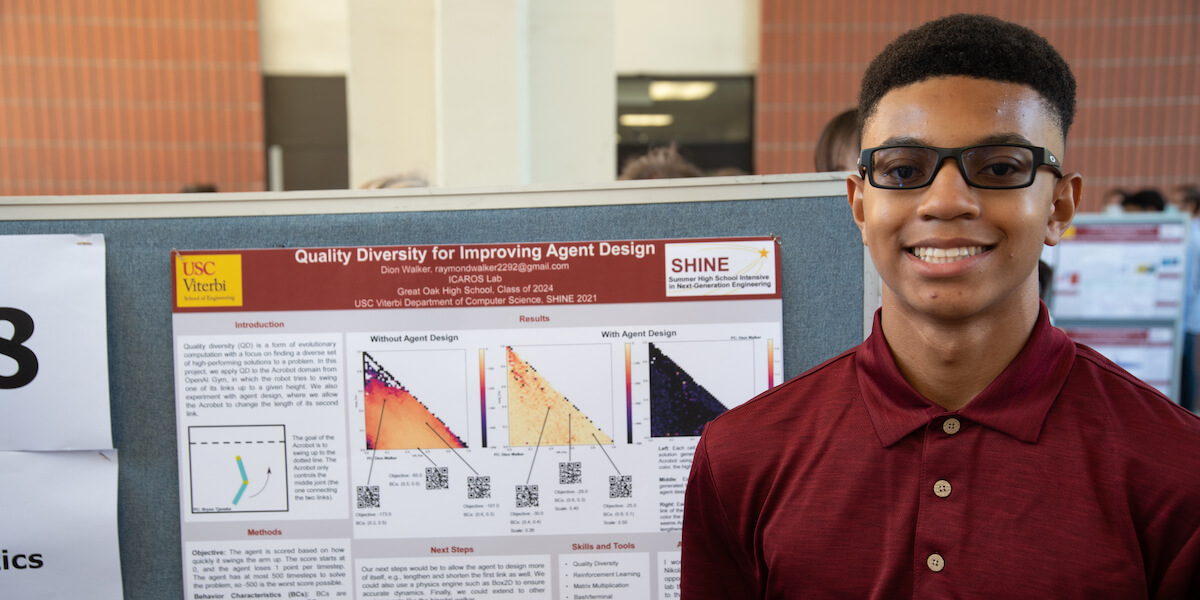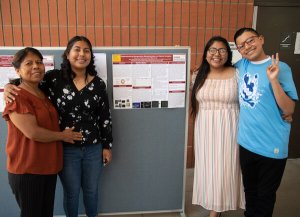
SHINE student Dion Walker, a rising sophomore at Great Oak High School, presented his research at the Poster Session. (Photo Courtesy of Rick Bolton)
On Friday July 30th, the 2021 session of the Summer High School Intensive in Next-Generation Engineering (SHINE) held its annual poster session, the program’s culminating event aimed to celebrate the work and accomplishments of the student participants. At the event, which occurred in person on-campus, SHINE students presented their research to their families and to USC Viterbi faculty, staff, and students.
Said Katie Mills, the co-director of USC Viterbi’s K-12 STEM Center and the founder and director of SHINE: “It was so exciting to see everything these students have accomplished over the past seven weeks. I am so proud of each and every one of them.”
A key program within the K-12 STEM Center, SHINE gives high school students the opportunity to join the engineering research team of a USC faculty member, exposing them to cutting-edge research in a real world setting. This summer’s session began on June 14th and brought together a cohort of 58 high school students from the Los Angeles area and beyond.
From using machine learning to enable early detection of wildfires to studying how robotics can improve treatment outcomes in children with autism, students immersed themselves in research projects that address real-world challenges in a wide range of engineering disciplines.
The poster session aimed to showcase the work and contributions of each SHINE student over the course of the seven-week program. Each student prepared a poster that summarized the objectives, methods, data, and results of their research projects. At the event, students presented these posters to faculty, peers and family. Later, they attended a ceremony where they each received a certificate acknowledging their accomplishments.

SHINE student Emily Ponce (second from left) pictured with mother Marciana Olivares, older sister Ariana Ponce, and nephew Andrew Ponce. (Photo Courtesy of Rick Bolton)
“The poster session was a really incredible experience. This event was so important to me and my family because I got to demonstrate my understanding of this particular research project to everyone that attended,” said Emily Ponce, a rising senior at the Orthopedic Hospital Medical Magnet High School who worked on a research team led by Cristina Zavaleta, a WiSE Gabilan Assistant Professor in the Department of Biomedical Engineering. “It was very exciting to interact and explain in depth the reasons why the research being done in Professor Zavaleta’s lab is crucial to society.”
Because of COVID, last summer’s session of SHINE occurred remotely. This summer, SHINE remained mostly remote, with the exception of a few students, including Ponce, working in the biomedical and environmental engineering labs who were given permission to work on campus.
“Last summer we faced a lot of the challenges that come with creating an effective research experience while remote,” Mills said. “So this summer, we were prepared and equipped to operate smoothly while online, and we were even able to take on more students. After another summer of remote work, it was so exciting to be able to come together in person at the poster session.”
Mills established the SHINE program in 2015 with the goal of creating an immersive STEM learning experience where high school students could be valuable contributors to real-world research. SHINE has alumni in some of the top engineering schools in the nation, including here at USC Viterbi, Harvard, CalTech, Stanford, UC Berkeley, Duke, and more.
Over the course of the seven-week program, students assisted their research team and learned research and problem-solving skills and content knowledge. Students worked closely with Ph.D. students and postdoctoral scholars that provide them with one on one mentoring.
In addition to assisting with research, SHINE students attended weekly training sessions where they learned more about university-level research. Mills and other expert staff lead these trainings, where students developed skills like lab research writing, scholarly literature searches, MATLAB coding, and science communication.
“My experience at SHINE was amazing,” said Dion Walker, a rising sophomore at Great Oak High School who worked on a research team in the Interactive and Collaborative Autonomous Robotics Lab under Stefanos Nikolaidis, a USC Viterbi assistant professor of computer science. “I got to experience what conducting research in my field of interest would be like, and I learned valuable lessons on speaking, how to read research papers, and much more from this program.”
“My experience at SHINE gave me a sense of confidence, exposure, and knowledge within the STEM field,” said Ponce. “The insight this program provides for the STEM field was truly life-changing to me because it gave me the clarity I was seeking for as a soon-to-be college applicant.”
What’s next for the SHINE program? SHINE coordinator Monica Lopez says that one goal for the program is to offer students the opportunity to work in an even greater variety of research areas by expanding collaboration to more professors.
“Most of all, I hope that in the future we continue to get to work with a diverse cohort of students who are eager to make the most out of their SHINE experience,” Lopez said.
The SHINE program will open applications to the 2022 cohort in the spring.
Published on August 26th, 2021
Last updated on April 25th, 2025







